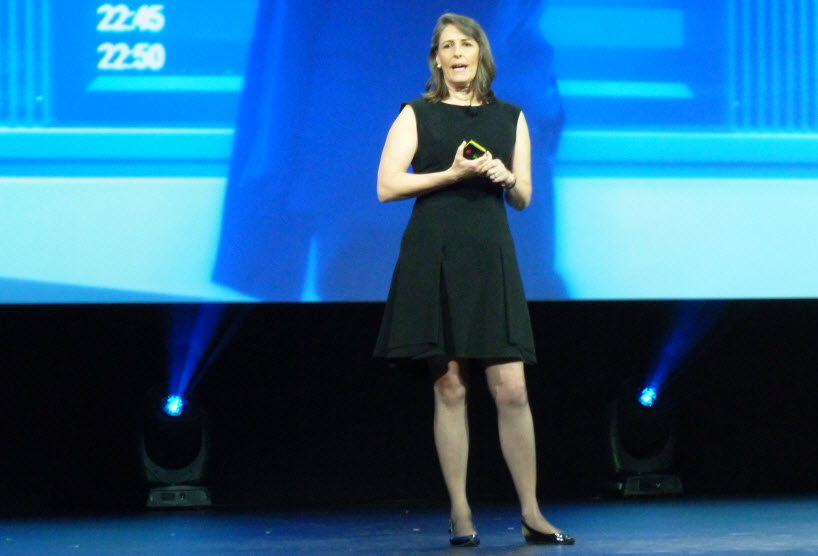 NEWS
NEWS
 NEWS
NEWS
 NEWS
NEWS
At IBM these days, it seems that Watson is the answer, regardless of the question.
The Day Two general session at IBM InterConnect 2016 in Las Vegas was the chance for the world’s most famous non-human Jeopardy! champion to take center stage. IBM says only one percent of applications have what is calls “cognitive” capabilities today, but that number is expected to swell to 50 percent by 2025.
IBM described – but didn’t demonstrate – two new Watson cognitive application program interfaces (APIs) and showed off what it said are significant enhancements to existing Text to Speech (TTS) and Tone Analyzer capabilities.
Tone Analyzer can interpret written text to detect attitudes, emotions and hidden meanings. Dineen Tallering, co-founder of the Watson-powered Connectidy dating app, showed how Watson APIs can be applied to conversations between prospective partners to detect inferred meanings and to suggest alternative wording for communications that might be misinterpreted.
“First impressions in online dating happen in writing, but 67 percent of the time when people send texts or emails they’re being misunderstood, even though they think their messages are coming across,” Tallering said. “Tone Analyzer lets you refine your messages to convey true intentions.”
The enhanced Text to Speech API enables developers to replace robotic speech synthesis with human-like spoken messages that better convey emotion. A new Emotion Analysis API can be applied to scan text to determine such emotions as joy or disgust, while Visual Recognition can learn from images to identify and categorize them more accurately. Both are in beta test.
“We communicate not just with data but with emotion and tone,” said David Kenney, IBM Watson general manager, who joined Big Blue in The Weather Company acquisition last fall.
Speaking of The Weather Company, attendees who were wondering about the reasoning behind that $2 billion deal probably went away disappointed, but probably not unimpressed. The big data company’s CTO, Bryson Koehler, ticked off an imposing list of facts about how much data that business manages: Several hundred terabytes are gathered each day from three billion weather forecast reference points, more than 40 million smartphones and 50,000 airplane flights. That data goes back out in the form of 26 billion daily personalized forecasts.
The reason IBM wants all that infrastructure still isn’t clear to everyone, but Koehler tried to put it in context. “As we capture lightning strikes and sensor data from connected cars, trains and stoplights, that gives us insight into what’s going on around us,” he said. “That can give you insights that change your business.” Koehler also explained the reasoning for the deal in an interview on SiliconANGLE’s theCUBE a day earlier (see video below)
APIs will be the way IBM exposes new functionality and will become the thread with which users stitch together cloud services, said Marie Wieck (above), general manager of cloud integration at IBM. Products like IBM’s new API Connect make it easier for developers to create, manage and secure APIs. Expect similar functionality for IBM Websphere and z-Series mainframes, with Bluemix tying it all together for developers.
IBM also used Day Two to highlight two areas in which conventional wisdom says it’s not a leader: Internet of Things (IoT) and security. In both areas, the conventional wisdom is wrong, executives said.
IBM is already working with 4,000 clients on paid IoT engagements, said Harriet Green, general manager of the Watson Internet of Things Commerce and Education organization. “We have more than 750 IoT patents, which is three times as many as any other country,” she said.
Watson can be applied to the 90 percent of sensor data that is generated at the edge of networks but never used, two-thirds of which data loses its value in less than a second.
The application of this technology to making buildings more energy-efficient is clear, but Green said there are other uses in areas like preventive maintenance, where split-second decision-making can identify failing equipment so it can be replaced without downtime.
Kone Corp. is using Watson to better understand how people move through urban areas, said Larry Wash, an executive vice president at the maker of elevators, escalators and other people-moving devices. In the near future, elevators will be summoned when people swipe identity badges at the security desk and will deposit riders at destinations derived from their smartphone calendars without prompting, he said.
That’s assuming hackers don’t mess with the works. IBM wrapped up the session with a demonstration of the firepower it’s bringing to the battle against cybercrime, a market in which it claims to already be the largest enterprise vendor.
IBM now employs 7,300 people in its security division and has added 1,000 in the last year alone, said Caleb Barlow, vice president of marketing and strategy for IBM Security. Two years ago the company made more than 700 terabytes of its own security data publicly available, and it intends to apply analytics to the discipline using – you guessed it – Watson.
“We’re beginning to use cognitive computing to power security systems that can understand, reason and solve security challenges in new ways,” Barlow said. And none too soon. According to IBM, more than one billion records are stolen every year, and medical record fraud grew 11,000 percent last year alone. Organized computer crime “is now one of the world’s largest economies with $445 billion in annual illegal profits,” Barlow said.
THANK YOU